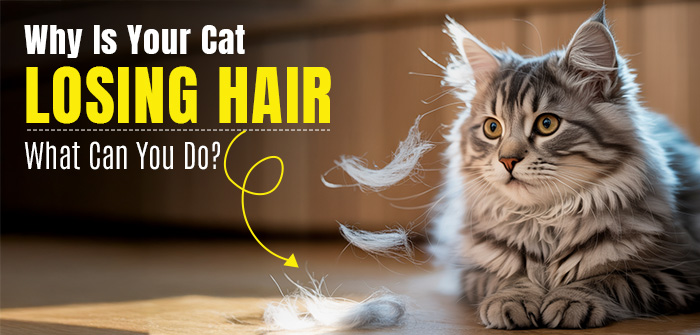Why Is Your Cat Losing Hair and What Can You Do?

Hair loss in cats, also known as feline alopecia, can be distressing for pet parents. From skin infections to allergies and beyond, cat hair loss has many potential causes. This blog will help you understand the possible causes behind the fur loss and what you can do to restore your cat’s healthy and fluffy coat.
What is Alopecia in Cats?
Alopecia refers to partial or complete hair loss in areas where fur is normally present. In cats, alopecia can be a symptom of various underlying issues, rather than a disease itself. Alopecia can occur anywhere on the body and may appear gradually or suddenly, with or without other signs like itching, redness, or lesions. Affected cats may lose large patches of fur in one area or across multiple locations.
What Causes Alopecia in Cats?
Generally, alopecia or hair loss in cats is caused by overgrooming or excessive licking. But if your cat is licking itself bald and itching and scratching the fur like crazy, then it is essential to identify its deeper root cause. There are several other reasons why your cat is losing hair. Here are some of the common causes of alopecia in cats:
1. Parasites
Excessive itching and licking leading to hair loss is one of the common symptoms of parasitic infections. When your cat is infected by fleas, mites, mange, or lice, they may irritate your cat’s skin and cause hair loss.
2. Allergies
Allergy-related hair loss in cats can be caused by various reasons. It can be due to food, environmental allergens like pollen and dust, or contact allergens like grooming products or detergents. If your cat’s hair loss is due to an allergy, it is important to rule out the allergens to prevent alopecia in cats.
3. Fungal/bacterial/viral infections
Fungal infections caused by ringworm are one of the most common causes of patchy hair loss in cats, whereas viral infections like feline leukemia hair loss in cats may also lead to this condition. Similarly, bacterial infections may also lead to scratching and redness of the skin, leading to hair loss in cats.
4. Overgrooming (Psychogenic alopecia)
Grooming is a comforting activity for most cats. They may excessively groom due to stress, anxiety, or boredom, leading to hair loss, especially on the belly, legs, or flanks. Sometimes, medical conditions or painful illnesses may also cause stress-related alopecia in cats.
5. Endocrine disorders
Health conditions like hyperthyroidism, Cushing’s disease, or diabetes can affect hair growth. If you do not notice any obvious causes for your cat’s hair loss, you must consult a veterinarian to rule out these medical conditions.
Diagnosis: How Vets Identify Alopecia Causes
If there are visible symptoms of alopecia, your veterinarian will perform the following tests to diagnose the cause of your cat’s hair loss.
- Physical examination and health history
- Skin scrapings or flea comb tests
- Fungal cultures (especially for ringworm)
- Blood tests to assess overall health
- Screenings for hormone imbalances
- Allergy tests or elimination diets
How to Treat Hair Loss in Cats: Options Based on the Cause
The treatment of alopecia in cats completely depends on the underlying cause. Once your veterinarian determines what’s triggering the hair loss, they will recommend a targeted course of action, which may include the following:
- Parasite control: If your cat’s alopecia is caused by parasites like fleas, ticks, mites, lice, etc., your vet will prescribe topical or oral flea and tick treatments to eliminate these parasites.
- Anti-fungal or antibiotic therapy: For alopecia caused by fungal or bacterial infections, such as ringworm or skin infections, antifungal or antibiotic therapies are typically used to clear up the infection and allow the hair to regrow.
- Hypoallergenic diets: In case of alopecia caused by food allergies, hypoallergenic diets or elimination diets can effectively help reduce the symptoms of alopecia.
- Anti-itch or anti-inflammatory medicines: If your cat is suffering from intense itching, redness, or skin inflammation, your vet may also prescribe anti-itch or anti-inflammatory medications to soothe the skin and promote healing.
- Behavioural support treatments: When alopecia stems from behavioural issues, such as excessive grooming due to stress or anxiety, treatment may include pheromone therapy (eg, Feliway Spray) or behaviour modification techniques to reduce stress and encourage natural grooming habits.
- Hormonal or disease-specific treatments: For alopecia related to underlying medical conditions such as a hormonal imbalance or systemic disease, your vet will recommend specific treatments to manage the root issue and restore your cat’s overall health.
Is Your Cat’s Hair Loss Permanent?
In the vast majority of cases, your cat’s hair will regrow once the cause is addressed and treated. However, prolonged overgrooming or scarring can sometimes lead to permanent bald spots.
What You Can Do at Home
- Monitor your cat’s grooming habits regularly.
- Inspect for external parasites, scabs, or redness.
- Avoid introducing new products without testing for allergens.
- Provide stress-relief tools like hiding spots and toys.
- Visit your vet early for accurate diagnosis and treatment.
Conclusion
Cat hair loss is a visible and often alarming sign that something isn’t quite right—whether it’s a physical health problem, behavioural issue, or allergy. With early detection and proper treatment, most cases are manageable and reversible. If your cat starts losing fur, consult your veterinarian promptly to get to the root cause. A soft, healthy coat could be just a few steps away.